Hello, everyone! I’m Michael Zhang, a passionate travel expert with extensive international experience. My love for exploring history and culture has taken me to countless destinations, uncovering the hidden stories behind iconic landmarks. Today, I invite you to join me on an in-depth journey through the National Museum of China, a treasure trove of over 5,000 years of Chinese civilization. Whether you’re a history buff or a curious traveler, this guide is packed with valuable insights for your visit.
Introduction to the National Museum of China
The National Museum of China, located on the east side of Tiananmen Square in central Beijing, stands as a symbol of the country’s rich cultural heritage. Facing the Great Hall of the People, this prestigious institution serves as China’s most significant center for collecting, researching, and showcasing cultural relics that represent the nation’s history. As a “cultural living room” for China, the museum plays a vital role in preserving national memories, passing down cultural legacies, and promoting global cultural exchanges.
- Address: 16 East Chang’an Avenue, Dongcheng District, Beijing, China
- Opening Hours: Daily 9:00 AM – 5:00 PM (Last entry at 4:00 PM; visitors must leave by 4:30 PM), closed on Mondays.
- Total Area: 70,000 m²
- Recommended Visit Duration: 5 hours
- Best Visiting Seasons: All year round
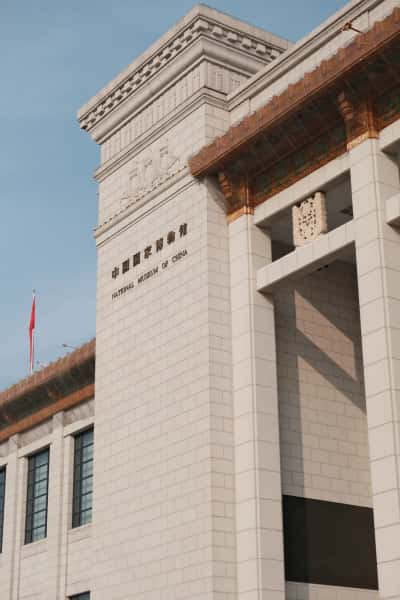
Why Visit the National Museum of China?
Architectural Marvel
The museum itself is an architectural masterpiece. Its distinctive design and grandeur immediately immerse visitors in the essence of Chinese civilization. From the moment you step inside, you’re surrounded by a sense of awe and cultural pride.
Diverse and Rich Exhibitions
The museum offers an extraordinary collection ranging from ancient ceramics and jade artifacts to modern historical relics. Each exhibit tells a story steeped in history, allowing visitors to journey through time and engage in meaningful conversations with the past.
A Hub for Cultural Education
The National Museum of China is not just a repository of artifacts; it’s also a platform for public education and cultural inheritance. Through various exhibitions and interactive activities, visitors gain a deeper understanding of Chinese history and traditions. For instance, the “Ancient China” exhibition on the underground level showcases national treasures like the Painted Pottery Basin with Human and Fish Patterns and the Square Zun with Four Rams. These exhibits provide a closer look at the craftsmanship and cultural significance of ancient China.
Things to Do in the National Museum of China
Main Attractions
The National Museum of China features exhibitions spread across one underground floor and four above-ground levels. Each floor offers unique insights into China’s rich history and culture, making it a must-visit destination in Beijing.
Ancient China Hall (B1 Level) – A Must-See
Located on the underground floor, the Ancient China Hall is one of the museum’s most significant exhibitions. This hall takes visitors on a chronological journey through Chinese civilization, from prehistoric times to the Ming and Qing dynasties. Artifacts on display include pottery, bronze, and jade pieces, each brimming with historical and cultural significance.
- Houmuwu Ding: This is the world’s largest bronze vessel, representing the pinnacle of bronze casting technology during the Shang Dynasty. Its sheer size and weight reflect the power and ceremonial traditions of the time.
- Square Zun with Four Rams: Known for its intricate carvings and sophisticated casting techniques, this vessel is a masterpiece of bronze art from the Shang and Zhou periods.
- Sanxingdui Bronze Mask: This enigmatic mask, originating from the ancient Shu civilization, showcases a worldview distinct from that of the Central Plains culture, adding a sense of mystery to China’s past.
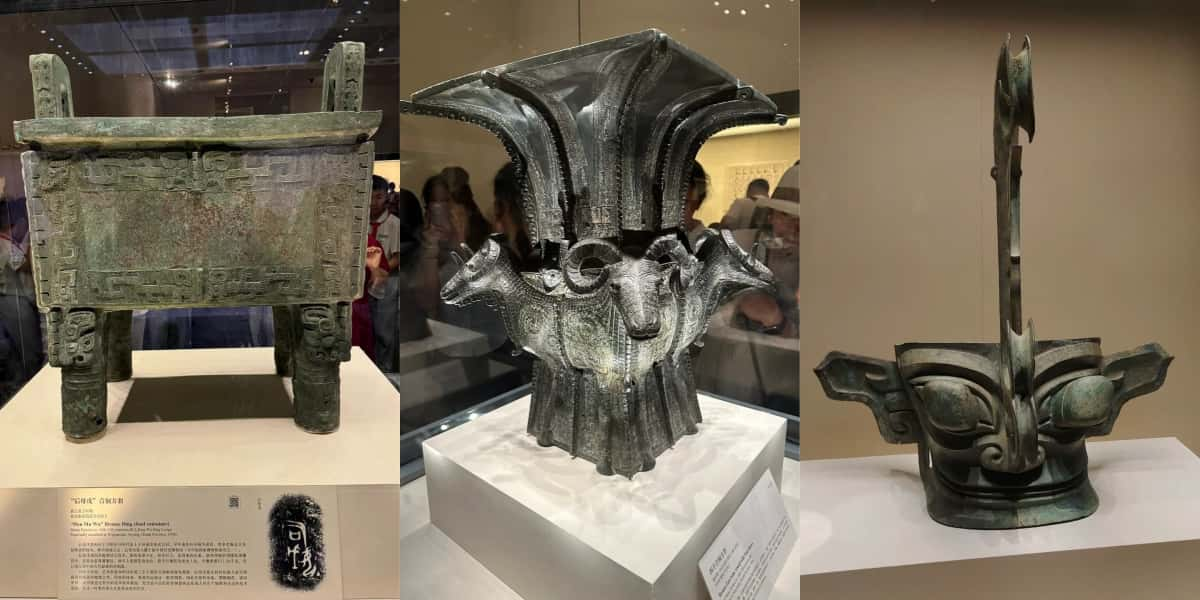
The Road to Rejuvenation Hall (1st and 2nd Floors)
The Road to Rejuvenation Hall chronicles China’s journey from the Opium War to the founding of the People’s Republic of China. Through photographs, historical artifacts, and multimedia presentations, visitors can trace the nation’s resilience and progress over the centuries.
- Must-See Treasures:
- Rabbit and Rat Heads from the Old Summer Palace: These two bronze sculptures, once looted and later returned to China, symbolize the nation’s cultural losses and subsequent revival.
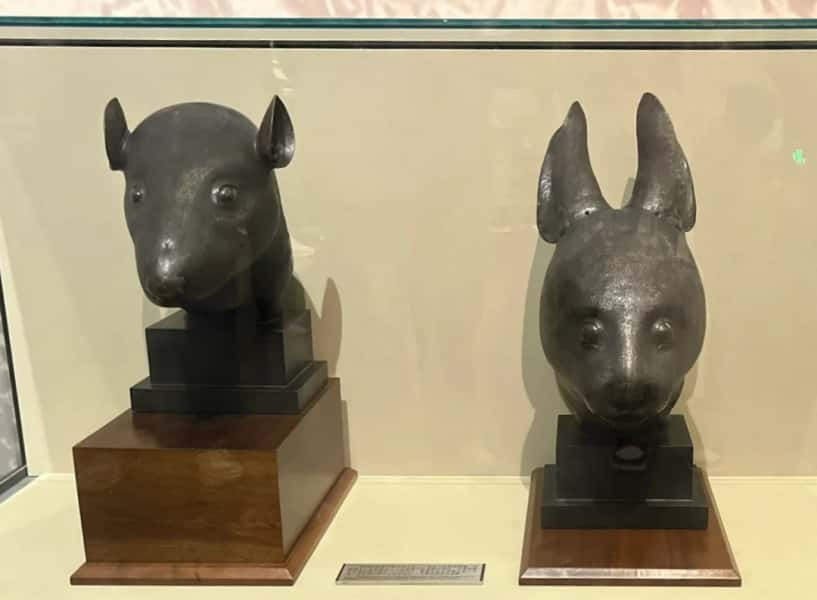
Chinese Ancient Diet and Diverse Splendor Exhibitions (3rd Floor)
On the third floor, the Chinese Ancient Diet Exhibition explores the evolution of Chinese culinary culture. This exhibit not only highlights traditional ingredients but also reveals the fascinating history of imported foods such as carrots and watermelons, showing how foreign influences have enriched Chinese cuisine over time.
Meanwhile, the Diverse Splendor Exhibition (special ticket required) offers a vibrant display of ancient Chinese lifestyle items, including clothing and tools. The craftsmanship and colors showcased here provide a vivid glimpse into the opulence of ancient China.
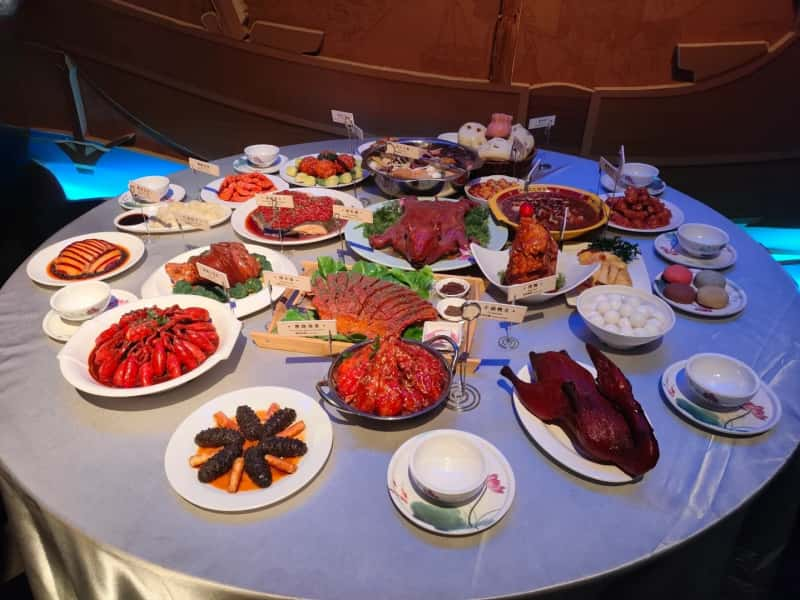
Ancient Ceramics and Jade Exhibitions (4th Floor)
The fourth floor is dedicated to the unparalleled artistry of ancient Chinese ceramics and jade. These exhibits capture the ingenuity and beauty of traditional craftsmanship.
- Ceramics Exhibition: Spanning works from Tang sancai (three-color glazed pottery) to imperial kiln pieces of the Ming and Qing dynasties, the ceramics display is a highlight. Be sure to admire the paper-thin white porcelain, which exemplifies the extraordinary skills of ancient artisans.
- Jade Exhibition: From Liangzhu culture’s jade cong to exquisite jade carvings from the Ming and Qing periods, this exhibit reflects the evolution of jade from practical use to artistic expression, showcasing the unique relationship between Chinese culture and jade.
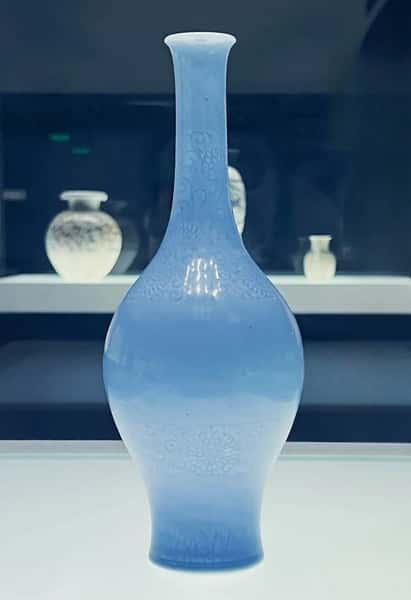
Ticket Guide for the National Museum of China
The National Museum of China offers free admission, but visitors are required to make an advance reservation. Some may come across references to ticket fees—these apply only to special exhibitions. Most visitors who purchase tickets for special exhibitions do so because general admission slots are often fully booked. This allows them to enter the museum by accessing the special exhibitions.
Ticket Prices
- General Admission: Free, but reservation is required. It is highly recommended to secure a free ticket in advance, as it grants access to the museum’s main exhibits. If general admission tickets are unavailable, consider purchasing tickets for special exhibitions.
- Special Exhibition Tickets (prices vary depending on the exhibition):
- Adults: 120 RMB per person.
- Children/Seniors: 60 RMB per person (applies to children aged 3–18 and seniors aged 60 or older).
- Free Entry: For children under 3 years old.
Opening Hours
- Open daily from 9:00 AM to 5:00 PM (last entry at 4:00 PM; visitors must leave by 4:30 PM).
- Closed on Mondays.
How to Reserve Tickets
- Online: Tickets can be reserved through the official website, the museum’s WeChat account, or popular online travel platforms. Early reservations are highly recommended, especially during peak seasons.
- Offline: Reservations cannot be made on-site.
Audio Guide Services at the National Museum of China
To enhance your visit and gain a deeper understanding of the exhibits, the National Museum of China offers an audio guide rental service. This service is particularly suitable for independent travelers who wish to explore at their own pace while learning more about the museum’s rich history.
- Rental Process: Audio guides can be rented at the museum entrance.
- Supported Languages: Mandarin, English, Japanese, and Korean.
- Cost: 40 RMB per device.
- Deposit: 100 RMB (refundable upon return of the device).
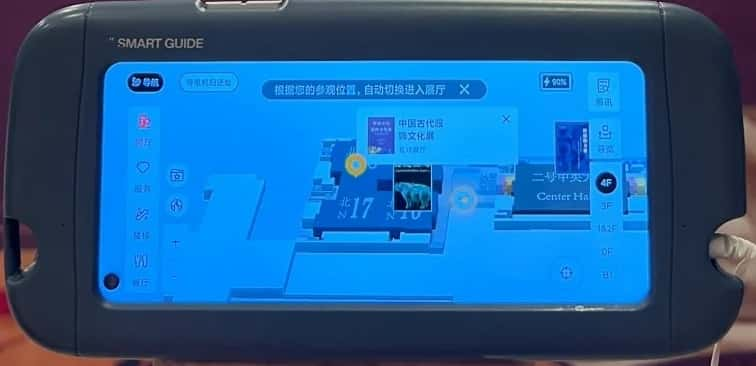
Recommended Itinerary for the National Museum of China
To make the most of your visit to the National Museum of China, follow this carefully curated itinerary. It covers the major exhibition halls and highlights the must-see artifacts. Set aside approximately five hours for a complete and immersive experience.
Stop 1: Ancient China Hall (B1 Level) – Approximately 2 Hours
Start your journey with the Ancient China Hall, the museum’s centerpiece and a treasure trove of artifacts spanning from prehistoric times to the Ming and Qing dynasties. This hall is organized chronologically into eight historical periods, offering a detailed overview of China’s rich history.
- Must-See Artifacts:
- Jade Dragon: A symbol of the Hongshan culture, reflecting the spiritual pursuits of ancient Chinese ancestors.
- Houmuwu Ding: The world’s largest bronze vessel, showcasing the pinnacle of bronze casting technology during the Shang Dynasty.
- Square Zun with Four Rams: A magnificent ritual wine vessel from the Shang and Zhou periods, known for its intricate carvings and advanced casting techniques.
- Sword of King Fuchai of Wu: A masterfully crafted bronze sword from the Warring States period, renowned for its elegance and razor-sharp blade.
- Tang Sancai Ceramics: Vibrant and lifelike, these three-color glazed pottery pieces exemplify Tang Dynasty artistry.
After exploring this hall, don’t miss the gift shop near the exit for unique souvenirs inspired by the museum’s collections.
Stop 2: Fourth Floor Galleries – Approximately 2 Hours
Next, head to the fourth floor, where you’ll find a stunning array of ancient Chinese art. This level is perfect for art enthusiasts who want to delve deeper into the beauty and craftsmanship of Chinese culture.
- Recommended Exhibitions:
- Currency Exhibition: Explore the evolution of Chinese currency from ancient coins to modern-day banknotes.
- Bronze Mirror Exhibition: Admire intricately designed mirrors that reveal the artistry of different historical periods.
- Clothing Exhibition: Witness the evolution of traditional Chinese attire and the techniques used to create them.
- Ceramics Exhibition: Don’t miss the breathtakingly delicate white porcelain pieces, as thin as paper and incredibly refined.
- Jade Exhibition: Discover the artistry of jade, from the practical tools of the Hongshan culture to exquisite decorative carvings from the Ming and Qing dynasties.
If your schedule is tight, prioritize the ceramics and jade exhibits, as they are among the most iconic.
Stop 3: Chinese Ancient Diet Exhibition (3rd Floor) – Approximately 30 Minutes
On the third floor, immerse yourself in the Chinese Ancient Diet Exhibition, which offers a fun and interactive look at the origins and evolution of Chinese culinary culture.
- Highlights:
- Learn surprising facts about imported foods like carrots and watermelons, which have become staples of Chinese cuisine.
- View traditional cooking utensils and serving vessels, gaining a deeper appreciation of China’s rich food culture.
Stop 4: Chinese White Porcelain Exhibition (2nd Floor) – Approximately 20 Minutes
Wrap up your visit with a stop at the Chinese White Porcelain Exhibition on the second floor, a favorite among art lovers and social media enthusiasts.
- Must-See Artifacts:
- The white porcelain pieces, with their paper-thin craftsmanship and polished luster, are a testament to the exceptional skills of ancient artisans.
- The famous white porcelain dress, part of the “Princess Yushu” theme, stands out for its elegance and weightless appearance, leaving visitors in awe.
How to Get to the National Museum of China from Downtown Beijing
By Subway (Recommended Option)
The subway is the most convenient way to reach the National Museum of China.
- Recommended Lines:
- Take either Line 1 or Line 2, and get off at Tiananmen East Station. Use Exit A or B, and walk a few minutes to the museum entrance.
- Why Choose the Subway?
- The subway station is located near the museum entrance, making it highly convenient.
- Tiananmen Square and its surrounding areas are restricted to taxis and rideshares, so these cannot drop you off directly at the museum.
- The subway saves time and avoids potential traffic jams, especially during peak hours.
By Bus
Taking a bus is another great option, particularly for those traveling from other attractions in Beijing.
- Recommended Routes:
- Buses 1, 2, 52, 82, and 120 stop at Tiananmen East Station, from which it’s a 5-minute walk to the museum.
- Important Tips:
- Bus stops may occasionally be relocated due to events or restrictions around Tiananmen Square, so check the routes in advance.
- This option is more suitable for travelers with light luggage, as buses can be crowded.
By Taxi or Rideshare
Due to restrictions around Tiananmen Square, taxis and rideshares cannot directly reach the museum entrance.
- Suggested Drop-Off Points:
- You can get dropped off near Qianmen Street or East Chang’an Avenue, both within a 10-15 minute walking distance of the museum.
- Additional Notes:
- Traffic congestion is common near Tiananmen Square, so subways are generally a faster and more reliable choice.
- If coming from a distant location, consider using a rideshare to the nearest subway station and continuing your journey by subway.
How to Get to the National Museum of China from Tiananmen Square
The National Museum of China is adjacent to Tiananmen Square, making it an easy walk.
- Walking Directions:
- From the east side of Tiananmen Square, walk eastward for about 5 minutes to reach the museum’s main entrance.
- Follow the pedestrian path along the edge of the square, and look for signs pointing to the museum’s large and distinctive building.
- Important Notes:
- Security checks are mandatory around Tiananmen Square, so allow extra time for this procedure before heading to the museum.
How to Get to the National Museum of China from the Forbidden City
The Forbidden City is located near the National Museum of China, making them a perfect cultural combination for a day’s itinerary.
- Walking Directions:
- Exit the Forbidden City through the Meridian Gate (South Gate).
- Walk south toward Tiananmen Square.
- Use the underpass beneath the Tiananmen Gate Tower to reach the east side of the square.
- Continue walking east for 10-15 minutes to arrive at the museum entrance.
- Travel Time:
- The total walking time is approximately 15 minutes.
- Advantages:
- The route provides a great opportunity to enjoy the impressive views of Tiananmen Square and the Great Hall of the People along the way.
Frequently Asked Questions (FAQ)
Is the National Museum of China Suitable for Strollers?
Yes, the National Museum of China is stroller-friendly. The spacious interior and elevators make it easy to navigate with strollers. Additionally, the museum offers free stroller rentals. Visitors can arrange this at the service desk by providing valid identification and paying a deposit of 500 RMB.
Where Can I Store Luggage?
Luggage such as suitcases, large bags, and items exceeding 40 cm in size must be stored at the designated baggage area.
- Baggage Storage Location:
- The storage facility is located to the left of the North Entrance.
- Storage Fees:
- Small items (under 30 cm): 2 RMB per item.
- Medium items (30–60 cm): 5 RMB per item.
- Large items (over 60 cm): 10 RMB per item.
- Important Note:
- All stored items must be retrieved by 5:00 PM on the same day. Storage services close after museum hours.

 English (US)
English (US)  English (Hong Kong)
English (Hong Kong)  English (Malaysia)
English (Malaysia)  English (Singapore)
English (Singapore)  繁體中文
繁體中文 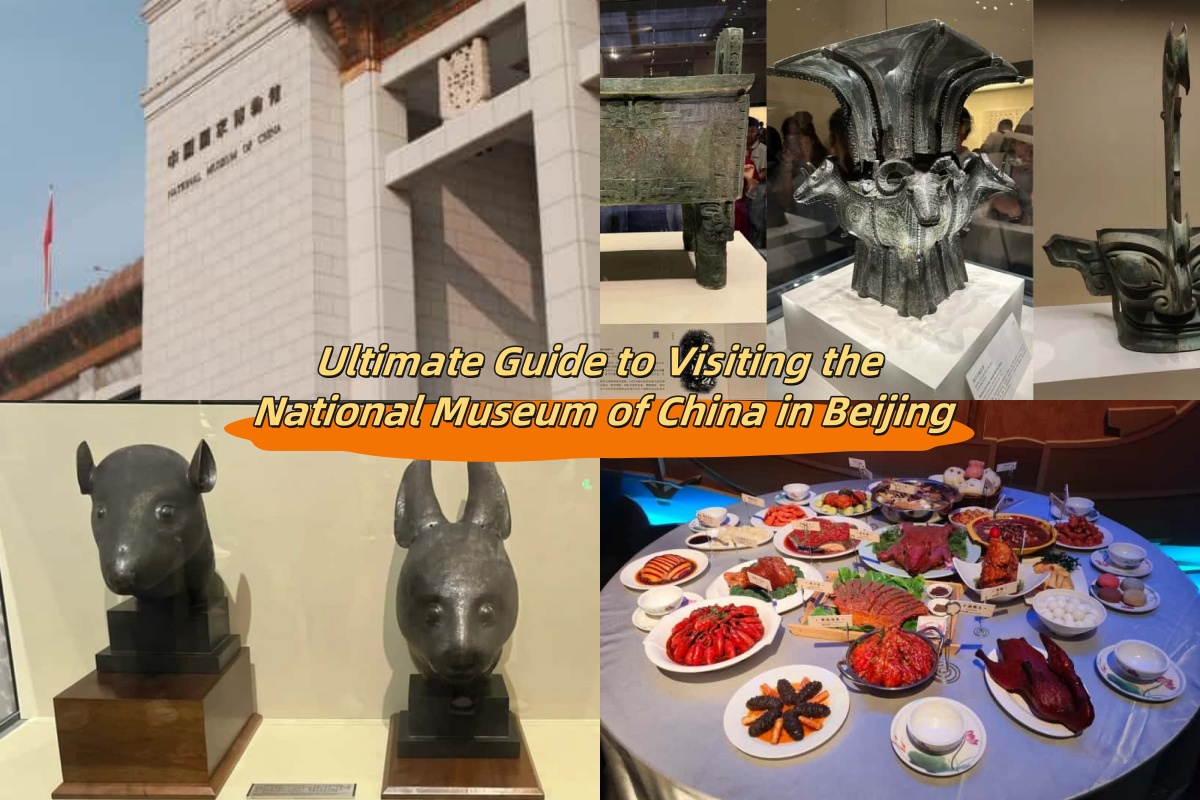
Comment (0)